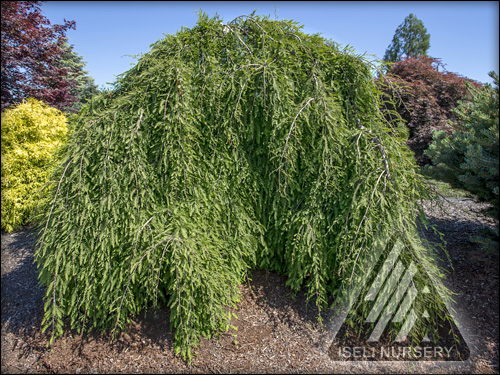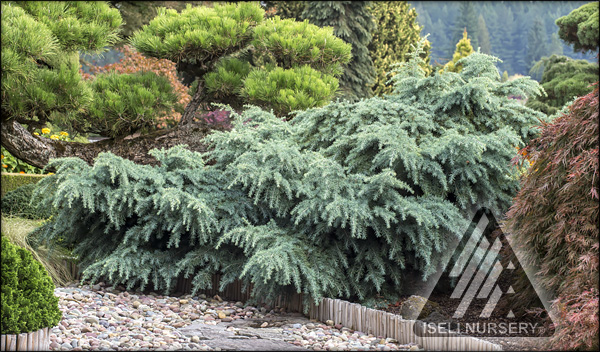Like the mesmerizing persistence of the tide lapping at the beach, pendulous and undulating plants provide a magnet for the eye, connecting the aerial garden back to the earth.

Pendulous plants all “weep” in their own peculiar way. Some, like Picea abies ‘Pendula’, the Weeping Norway Spruce, are not predictable upright growers without some guidance. Staked up to a desired height they then cascade downward and trail laterally once they reach the garden surface. These graceful plants inch their way over rigid barriers and teasingly cross otherwise delineated borders with impunity and style.
Other “weepers” like, Picea glauca ‘Pendula’, the Weeping White Spruce, have strict constitutions sending them predictably upright, reaching for the heavens, while their branches hug their rigid spire frames like wet clothing clings to the gardener caught out in a summer rainstorm.
For dry climates, Pinus banksiana ‘Uncle Fogy’ presents a bizarre but creative addition to the garden. This large sturdy two-needled jack pine grows upright, yet its branches wildly extend with both pendulous and undulating branchlets. These branchlets are not dense, yet not sparse, and the needles on the branchlets twist upward in a slight semi-circle. The winter buds are densely covered with resin giving it a frosty appearance in the morning winter sun.
Some pendulous trees appear to take on animate forms as they mature to stir garden interest in our children and grandchildren, and convey a few youthful memories. One that immediately comes to mind is, Sequoiadendron giganteum ‘Pendulum’, the Weeping Giant Redwood. It fancifully mimics the mammoth-like Snufflufagus from Sesame Street with its falling branches full of long or dense needles swinging in the breeze. The main trunk grows predominantly upright, occasionally dipping, and then growing upright again. It often develops secondary branches that bob and weave. The scale needles are a long soft green and flow gracefully in the breeze. The bark is thick and fire resistant. Just when you have marveled how its profile resembles a llama, continued growth transforms it into a mastodon.

True “mastodons” in relation to their prehistoric roots are Taxodium distichum ‘Cascade Falls’, the Weeping Bald Cypress. While we haven’t yet found its fossil heritage, Taxodium is so closely related to the dawn cypress, Metasequoia glyptostroboides, it must be from the same period. ‘Cascade Falls’ is a vigorous grower that is usually grafted to the desired height on species understock. In wet soils it quickly covers its stem falling swiftly to the garden floor.
Cedrus atlantica ‘Glauca Pendula’, the Weeping Blue Atlas Cedar, is a true cedar which needs help initially needs help to get to its desired height. Its branches seem to want to arch away from the trunk in its journey to the garden floor, while its branchlets with powder blue needles laying flat on the stem fall like rain toward the earth. This cedar is often used as a living fence that is trained to a trellis to border a special garden spot or arch over an alley entrance.
Chamaecyparis nootkatensis ‘Strict Weeping’ wants to skyrocket into the clouds. In 20 years it may reach a 20 foot height and a 12 foot base with lower branches that strike upward in support of the strong central leader. ‘Strict Weeping” is a mild green with upward growing weeping branching and loose branchlets that fall back downward from the leader and gently sway in the breeze.

Cedrus deodara, the Deodar cedar, is a large stately conifer with horizontal spreading branches and a conical shape. Much too large for smaller gardens, it can grow to 150 feet tall with a 40-foot spread. However, Cedrus deodara ‘Prostrate Beauty’ is compact, low-growing and powder blue and it has the cutest, softest appearance in the garden. It layers as its spreads, gently arching up and out. The pendulous branchlets are laden with the typical deodara needles, narrow but thickly placed, creating a dense appearance. “Prostrate Beauty’ makes an excellent focal point.
From the Mexican to the Canadian borders, American gardeners are presented with an alluring choice of weeping conifers that can add form, color and textural contrast to the mixed border. Combine upright forms with mounding, loose and informal types with tight and formal. If it’s a narrow border, stick with the narrow uprights combined with miniatures and dwarfs. Add a few broadleaf shrubs, some grasses, a few annuals and perennials, and you have an attention-grabbing, four-season garden.

You must be logged in to post a comment.